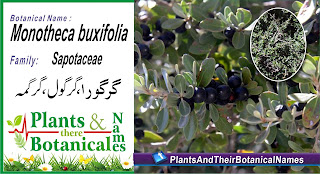Monotheca buxifolia
Etymology of the Name "Gurgura": The singular form of this fruit is "Gurgura," and its plural form is "Gurguri" in the local dialect. In other dialects, it is referred to as "Gargarah" or "Gargora," with its plural form being "Gargari" or "Gargori," similar to how the word "گل" (flower) is pronounced as "گول" (flower) in the local dialect. "Gurgura" as a feminine noun is used in the local dialect.
Names of Gurgura in Other Languages: In Pashto, especially among the Pashtun tribes, this fruit is known as "Ghingoray." The introduction of "Ghingoray" into the Pashto language may have occurred due to the proximity of the Hindko language (spoken by the Shinwari tribe) to Pashto. After the arrival of the British in the region, they named it "Wild Blackberry" due to its resemblance to blackberries.
Botanical Name of Gurgura: Some botanists refer to this fruit as "Monotheca buxifolia."
Family of the Gurgura Tree: The tree bearing the fruit "Gurgura" belongs to the family "Sapotaceae," which includes around 800 species of evergreen trees and shrubs.
Shape and Size of the Gurgura Tree: The tree on which this fruit grows is similar in shape and size to an olive tree, but unlike olive trees, it has thorns. Therefore, one must be careful while plucking it. The tree naturally grows in mountainous regions and does not require regular cultivation.
Stages of Gurgura Fruit Growth: The fruit appears in May. The tree first blooms, then green, round fruits emerge. Over time, the fruits turn reddish and eventually black, becoming delicious and ready to eat in June. People enjoy the fruit both fresh and dried.
Benefits and Drawbacks of Gurgura Fruit: Gurgura fruit is beneficial for the digestive system but should not be consumed in large quantities to avoid mouth sores and digestive issues.
Gurgura in Pashto Literature: In local areas, various wild fruits, including "Gurgura," are abundant. However, in Pashto literature, this fruit has been specifically mentioned. Poets have used it as a metaphor or symbol in their verses, often expressing longing or desire.
It is worth noting that the information provided here is based on the local dialect and cultural references of the Shinwari tribe in Mardan District, Khyber Pakhtunkhwa, Pakistan. Different regions and tribes may have their own names and variations for this fruit.





No comments